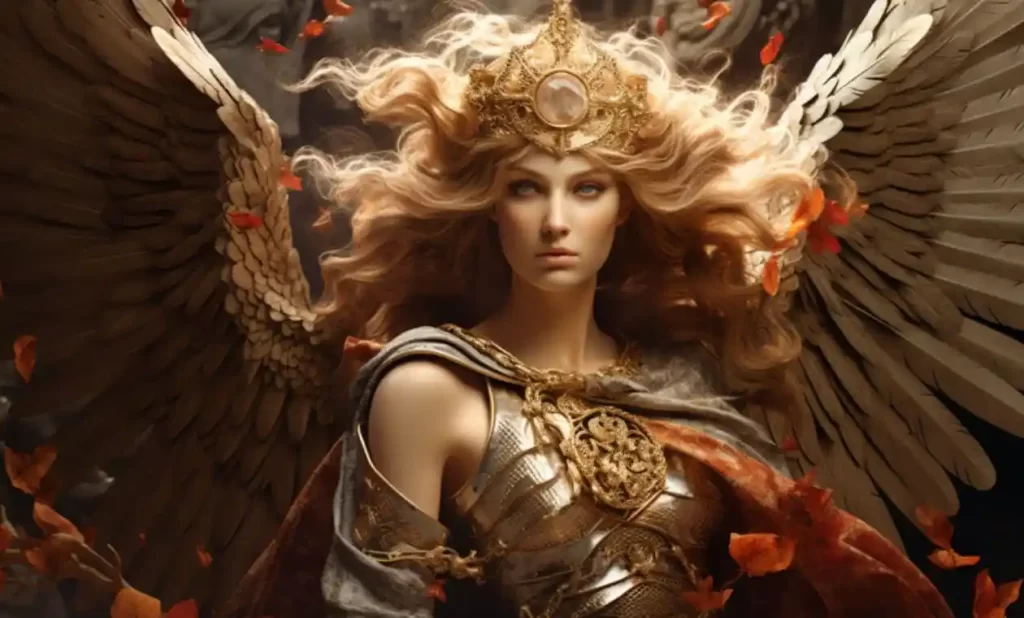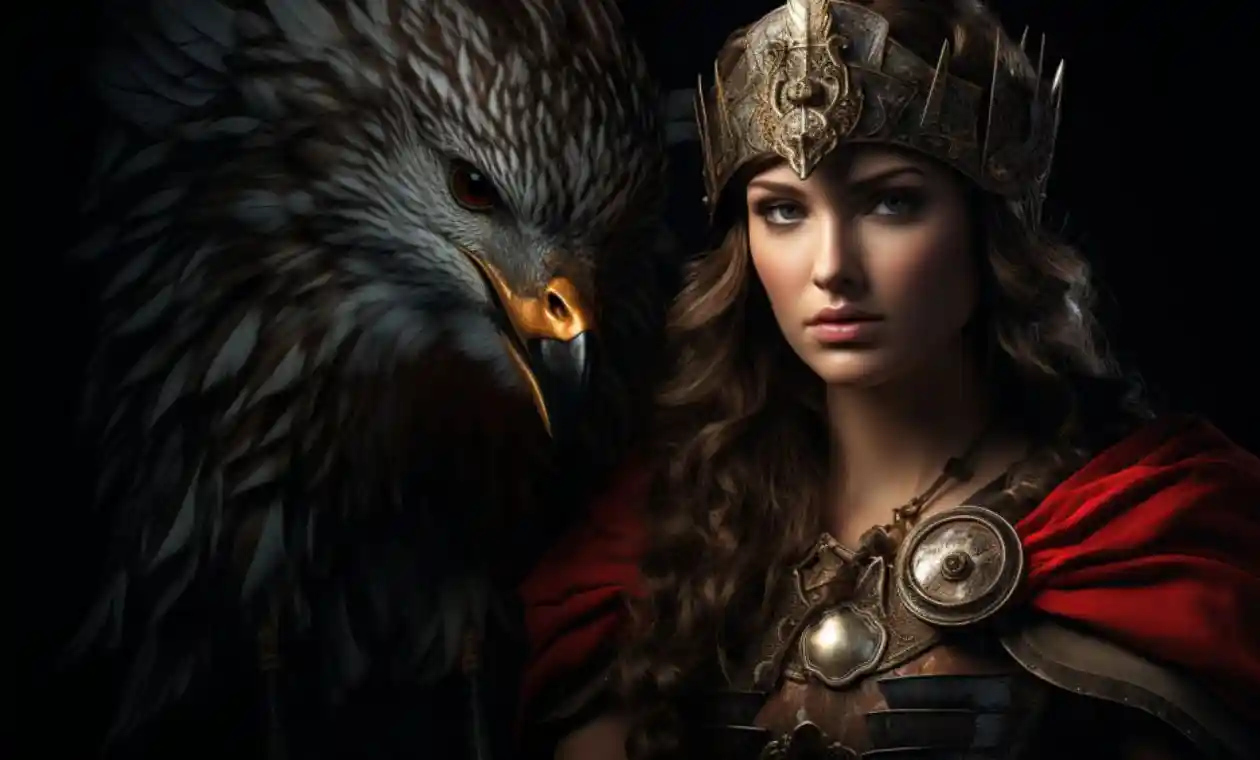
In the heart of what was once a vast empire, where columns of marbled stone touched clear blue skies and cobbled streets resonated with the murmurs of countless tales, there thrived a civilization that has left an indelible mark on history. This was Ancient Rome, a realm where myths intertwined with reality, and gods and goddesses were as real to the people as the Colosseum’s grandeur or the soft glow of torches lining the Tiber at dusk.
Amidst this backdrop, a particular tale stands out – that of a powerful and wise goddess, a beacon of knowledge and protector of the city. She wasn’t just any deity; she was Minerva, the goddess of wisdom, arts, and warfare. As we journey through her story, we’ll discover a figure that embodies the spirit of Rome in its golden age. Let’s step back in time, where our story of Minerva awaits, and immerse ourselves in the enchanting world of Roman myths and legends.
Chapter 1: The Miraculous Birth of Minerva
In a time before Rome’s grandeur, when the world was still young and gods played their games in the vast heavens, a tale of wonder took shape. The skies were ruled by mighty Jupiter, the king of all gods, whose thunderous roars and benevolent whispers shaped destinies.
One day, an excruciating headache plagued Jupiter. The pain was so immense, unlike anything he had ever felt. It wasn’t just a mere ailment; it was as if something, or someone, was trying to break free. Desperate for relief, he asked the god Vulcan, the blacksmith of the deities, to strike his head with an axe to release whatever was causing this torment.
And then, in an event that left even the eternal gods in awe, from the split in Jupiter’s skull, fully armored and with an air of wisdom and authority, sprang Minerva. She didn’t come into the world as a babe, crying for warmth, but as a grown goddess, ready to claim her place among the pantheon of Roman deities. This miraculous birth from the mind of the mightiest god symbolized her dominion over intellect and wisdom.
Her birth was not just a marvel but also a proclamation. Here was a goddess who was born from thought itself, representing wisdom in its purest form. Minerva’s connection to Jupiter was evident not just in her birth but also in her stature. She quickly became one of the most revered deities, often standing shoulder to shoulder with Jupiter in matters of importance.
As the people of Rome would later come to believe, Minerva wasn’t merely a goddess to be worshipped. She was the embodiment of intellectual pursuits, strategic warfare, and artistic endeavors. She was a testament to the idea that wisdom and knowledge were born from the greatest challenges and trials.
And so, in the heart of a budding empire, the legend of Minerva began, a tale woven from the very fabric of divinity, setting the stage for countless stories and legends that would shape the course of Roman mythology.
Chapter 2: Minerva – The Radiant Beacon of Roman Pantheon
In the bustling streets of Rome, children played, soldiers marched, and poets sang tales of heroics. Among the myriad of stories that floated in the air, Minerva’s tales were special. The mere mention of her name evoked reverence and awe.
But who was this Minerva?
In Roman mythology, Minerva stood tall, not just by stature but by her vast domain. She wasn’t a goddess confined to a single attribute. No, Minerva was a tapestry of talents, woven together to create an entity that was multifaceted and multidimensional.
First and foremost, she was the goddess of wisdom. The Romans believed that Minerva granted the gift of intellect, guiding scholars, thinkers, and philosophers in their pursuits. In the hallowed halls of Roman academies, her name was often invoked for enlightenment.
But wisdom wasn’t her only domain. Minerva was also the patron of arts. From the delicate strokes of painters to the harmonious tunes of musicians, from the skilled hands of craftsmen to the eloquent words of poets, Minerva’s influence was everywhere. She was the muse who ignited the spark of creativity, pushing artisans to reach the pinnacle of their craft.
Warriors, too, sought her guidance, for she was the goddess of strategic warfare. Unlike Mars, who represented the brute force and fierceness of war, Minerva symbolized the strategy, the planning, the tactics. She taught that battles were not just won by strength but by intellect.
To the everyday Roman, Minerva was a constant presence. She represented the perfect amalgamation of thought and action, of wisdom and application. She was the voice in the back of their heads, urging them to think, to strategize, to create.
Answering the age-old questions: “Who is Minerva in Roman mythology?” and “What is Minerva the goddess of?” is no simple task. For she was not just a deity to be adored from afar. She was a part of life, a guiding force, and a symbol that wisdom, art, and strategy were the cornerstones of a great civilization. And in her, the Romans found a reflection of their highest ideals and aspirations.
Chapter 3: The Emblems of Minerva – From Owls to Olive Trees

As the morning sun began to rise over Rome, casting its golden hue on the sprawling city, the silhouettes of countless statues and emblems dedicated to the gods became evident. Among them, certain symbols stood out, whispering tales of Minerva’s essence to anyone who would listen.
Symbols in ancient times weren’t mere decorations; they were profound representations, telling tales and carrying the essence of what they symbolized. For Minerva, these symbols were not only identifiers but also an extension of her divine persona.
The most recognizable of all her symbols was the owl. This nocturnal bird wasn’t chosen randomly. The owl, with its penetrating gaze and ability to see in the dark, was the perfect representation of wisdom and knowledge. Just as an owl could see through the darkness, so too could wisdom illuminate the murkiness of ignorance. Every time Romans saw an owl, they were reminded of Minerva’s presence, watching over them, guiding them towards enlightenment.
Answering the question, “Why is the owl often associated with Minerva?”, one needs to understand the deep connection between wisdom and vision. In a world without the conveniences of modern illumination, the ability to see in the dark, to navigate the unknown, was a powerful metaphor. The owl, with its nocturnal vision, embodied the idea that wisdom could guide one through life’s darkest moments.
But the owl was not the only emblem sacred to Minerva. The olive tree, with its sprawling branches and fruit that provided sustenance, symbolized peace and abundance. Just as an olive tree nourishes those who tend to it, Minerva’s wisdom nurtured the minds and souls of those who sought her guidance.
The helmet and the spear, symbols of warfare, were also associated with her. Unlike the god Mars, who charged into battle with raw force, Minerva’s approach was different. She taught that wars were not just won on the battlefield but in the war rooms, with strategy and foresight. The helmet and spear were reminders that Minerva was not just a goddess of intellect but also of action.
As the sun climbed higher in the sky, casting its light on the vast empire, the symbols of Minerva shone brightly, each telling a tale, each a testament to a goddess whose influence was as vast as her domain.
Chapter 4: Echoes of Antiquity – Minerva’s Mythic Legacy
As evening descended upon Rome, families would gather around, and the oldest among them would recount tales of gods and mortals, weaving together the fabric of their cultural legacy. Minerva, with her multifaceted nature, featured prominently in these tales.
Answering the question, “Are there any famous myths or stories featuring Minerva?” brings us to the heart of Roman mythology. Indeed, there are stories, rich and varied, that shine a light on Minerva’s influence and character.
Minerva and Arachne: A Tale of Pride and Divine Retribution
In the annals of Roman mythology, many stories capture the intricate dance between mortals and gods. But few resonate as deeply as the tale of Minerva and Arachne, which underscores the consequences of unchecked pride and the importance of reverence for the divine.
Arachne was not just any mortal; she was a weaver par excellence. Her fingers moved on the loom like a maestro commanding an orchestra, weaving threads into tales that left onlookers spellbound. Her mastery was such that whispers began to circulate, suggesting that even Minerva, the goddess of crafts, couldn’t rival Arachne’s skill.
Pride, often blinding, led Arachne to boast about her superior abilities. She claimed her talent outshone even that of the divine Minerva. Such audacity did not go unnoticed. Wanting to see this mortal’s confidence firsthand, Minerva approached Arachne in the guise of an old woman. She suggested a weaving duel, a direct face-off to ascertain who was truly the master of the craft.
With the stage set, both weaver and goddess embarked on their artistic battle. Each tapestry unfurled was a testament to the unparalleled genius of its creator. However, the content of their weavings starkly contrasted. While Minerva showcased the might and benevolence of the gods, Arachne took a daring route. Her tapestry portrayed the gods in compromising, often scandalous, narratives, throwing shade on their divine stature.
When the cloths were revealed, there was no denying Arachne’s craftsmanship. However, the blatant disrespect and sacrilege depicted in her tapestry enraged Minerva. It wasn’t just about a mortal claiming superiority in skill; it was a direct affront to the divine order. The gods, after all, were not to be mocked.
Seething with anger, Minerva tore Arachne’s tapestry and touched the mortal with a rush of divine energy. Before the eyes of the onlookers, Arachne’s form began to contort and shrink. Her once nimble fingers elongated, her body compressed, and soon, the master weaver was transformed into a spider. Condemned by Minerva, she was destined to weave, not grand tales on a loom, but delicate webs for all eternity.
Minerva and Neptune: The Divine Duel for Athens
The ancient world was a theater of divine contests, with gods vying for honor, admiration, and the chance to be the protector of cities. One such spirited rivalry played out between Minerva (known as Athena in Greek) and Neptune (or Poseidon, as the Greeks called him) over the city that would eventually be named Athens.
Both deities, immensely proud and influential in their own right, sought patronage over this budding city. In their bid to become its guardian, they decided to bestow gifts upon it, with the city’s inhabitants choosing the gift they deemed more valuable.
Neptune, the god of the seas, was first to present his offering. With a powerful strike of his trident, he cleaved the earth, and from this chasm sprang forth a fountain. While the sight of water springing from the land was awe-inspiring, there was a drawback. The water was as salty as the sea, rendering it unfit for drinking or farming. While symbolic of Neptune’s dominion over the oceans, it didn’t offer much practical use to the citizens.
Then came Minerva’s turn. The goddess of wisdom, strategy, and crafts approached with a softer touch. She planted a seed into the earth, which rapidly grew into a robust olive tree, right before the astonished eyes of the city’s denizens. Unlike Neptune’s dramatic but somewhat impractical gift, Minerva’s olive tree was a treasure trove. It promised olives for sustenance, oil for lamps and cooking, and wood for various uses. In a single gesture, Minerva showcased her wisdom, foresight, and the practical benefits of her patronage.
The citizens of the city, after deliberating, chose Minerva’s olive tree over Neptune’s saltwater spring. They recognized in her gift a future of prosperity, growth, and sustainable resources. As a mark of gratitude and honor, the city was named Athens, paying eternal tribute to its divine benefactor, Athena (or Minerva, in Roman terms).
Minerva’s Flute: A Melody of Vanity and Mockery

The ancient deities, while mighty and revered, were often portrayed with very human emotions, desires, and insecurities. Among such tales, the story of Minerva and her crafted flute offers a fascinating insight into the fragile pride of the divine and the dangers of mockery.
Minerva, in her infinite creativity and wisdom, once fashioned a flute using reeds. The instrument, with its delicate and unique design, promised to produce melodies that could enchant listeners. When Minerva placed the flute to her lips and played, the music was, as expected, exquisite, weaving a tapestry of sounds that could resonate with the soul.
However, the gods around her, instead of being spellbound by the melody, found themselves chuckling. Not at the tunes Minerva played, but at the sight she presented. As she played, her cheeks ballooned with each breath, puffing out in a manner the gods found hilariously unbecoming.
The laughter of her fellow deities pierced Minerva’s pride. Feeling deeply embarrassed, the goddess of wisdom did not see the humor in their jest. Her creation, which she had crafted with love and care, had become a subject of ridicule, making her feel exposed and humiliated.
In her anguish, Minerva cast the flute away. But she didn’t just discard it. She cursed the instrument, decreeing that it would bring misfortune to anyone who dared to pick it up and play. In doing so, she transformed her flute from a symbol of creativity and joy into an emblem of scorn and danger.
The story of Minerva and her flute is a poignant reminder of the vulnerabilities even gods possess. It underscores the idea that while creativity and innovation can be a source of immense pride, they can also expose one to criticism and ridicule. Moreover, the tale serves as a warning about the perils of mockery, suggesting that making light of someone’s earnest efforts can have unforeseen consequences. In the world of gods and mortals, respect, understanding, and kindness stand tall as virtues worth cherishing.
Minerva’s Aegis: The Protective Power of Medusa
In the pantheon of Roman mythology, shields and weapons often bore significant symbolism, carrying stories and meanings far beyond their immediate function in battle. Among the most iconic of these is Minerva’s shield, the Aegis, which prominently featured the face of Medusa, the snake-haired Gorgon.
To understand the significance of this emblem, we must first delve into the tragic tale of Medusa. Once a beautiful maiden, Medusa was transformed into a Gorgon, with serpents for hair, as punishment by Athena (Minerva’s Greek counterpart) for a transgression that occurred in Athena’s temple. Despite the curse, Medusa’s face retained its mesmerizing power. But now, instead of captivating onlookers with its beauty, it turned them to stone with a single gaze.
When Minerva chose to emblazon her shield with the face of Medusa, it wasn’t out of spite or to commemorate Medusa’s punishment. Instead, the image served a dual purpose: practical and symbolic.
On a practical level, Medusa’s visage was a potent weapon in battle. Enemies who dared to look directly at the Aegis were turned to stone, rendered immobile by the sheer terror of Medusa’s countenance. This offered Minerva an advantage, making her an even more formidable force in any confrontation.
Symbolically, the Medusa emblem encapsulated Minerva’s role as a protector of cities, heroes, and the Roman realm. Just as city walls and fortifications deter invaders, the fearsome image of Medusa on Minerva’s shield served as a deterrent, a warning to any who would oppose or threaten the realms under her guardianship.
The Aegis, with its prominent Gorgon, stands as a testament to Minerva’s wisdom. By harnessing the power of Medusa’s tragic curse, she transformed a symbol of terror into one of protection, encapsulating her dual role as both a warrior and a guardian in Roman mythology.
These stories, each echoing with morals and teachings, painted a vivid picture of Minerva. They showed her not just as a deity of wisdom but also of artistry, competition, protection, and sometimes, retribution. Through these tales, the Romans found guidance, inspiration, and occasionally, warnings – a testament to Minerva’s profound impact on their daily lives and beliefs.
Chapter 5: The Pillars of Wisdom – Minerva’s Sacred Sanctuary
In the heart of ancient Rome, where the hustle and bustle of daily life intertwined with the whispers of the gods, stood structures of immense significance. Temples, mighty and grand, were more than just edifices of stone and marble. They were places of worship, symbols of faith, and repositories of ancient legends. Among these, the Temple of Minerva held a special place, both in its physical prominence and spiritual importance.
The Seat of Wisdom – Minerva’s Temple:
Nestled in the Forum of Nerva, this sacred sanctuary was a testament to Minerva’s profound impact on Roman life. With its grand columns reaching towards the sky and intricately carved statues, it was not just an architectural marvel but a focal point of Roman religious observance.
Answering the question, “Where was the Temple of Minerva located in ancient Rome?”, we find ourselves transported to the heart of the city. The Forum of Nerva, also known as the Transitional Forum, was one of the Imperial forums of Rome. It was here, amid bustling marketplaces and grand processions, that Minerva’s temple stood tall, offering solace to those who sought her wisdom.
A Beacon of Knowledge:
The Temple of Minerva was not just a place of worship. It was a center of learning. Scholars, poets, and philosophers would often congregate under its shade, engaging in spirited debates, penning down epic tales, and seeking inspiration from the goddess of wisdom herself.
Festivals and rituals dedicated to Minerva were regularly held here. During these events, the temple would be adorned with garlands and flowers, and the air would be filled with songs, chants, and the soft murmur of prayers.
The Temple’s Legacy:
Over time, while empires rose and fell, and the tides of history reshaped the world, the Temple of Minerva remained a constant, a silent witness to the ebbs and flows of time. Though the actual structure suffered the ravages of time, its legacy was undying. The values, teachings, and beliefs associated with Minerva continued to inspire generations, long after the temple’s physical demise.
In the heart of modern Rome, among its ruins and relics, the spirit of the Temple of Minerva still lingers, reminding us of a time when gods walked among mortals and when wisdom was the highest virtue. The Temple’s tale, though etched in stone, is very much alive in the annals of Roman history, culture, and tradition.
Chapter 6: Celebrating Wisdom – Minerva’s Dance with Rome
As dawn painted the Roman sky with hues of gold and amber, the city would often awaken to a different kind of fervor. On certain days, the clatter of shops and the hum of daily chores would merge with the rhythmic beat of drums and the chorus of songs. These were the days dedicated to Minerva, the goddess whose essence was woven deep into the Roman fabric.
Minerva in Daily Roman Life:
Minerva was not a distant deity, relegated only to tales and temple walls. Her presence was palpable in the everyday life of the Romans. Scholars invoked her before embarking on their studies. Craftsmen whispered prayers to her, hoping to perfect their art. Soldiers sought her guidance to strategize their moves in battles.
Her symbols, especially the owl, were common motifs in Roman households, acting as protectors and bearers of good fortune. Children grew up listening to tales of her wisdom, valor, and artistic prowess, imbibing the virtues she epitomized.
The Quintessential Festival – Quinquatria:
Answering the question, “What role did Minerva play in Roman daily life and festivals?” requires a dive into the most significant festival dedicated to her – the Quinquatria. Held from the 19th to the 23rd of March, this five-day festival was a celebration of all things Minerva.
The Quinquatria commenced without bloodshed – a day when no war was waged, and no beast was sacrificed. This was a nod to Minerva’s preference for wisdom over warfare. Schools took a break during these days, but they weren’t days of idleness. Students would pay their respects to their teachers, offering gifts as tokens of gratitude.
Artisans and craftsmen showcased their finest works, honoring the goddess of craft and art. Musicians, dancers, and poets would regale the public with performances, turning the city into a vibrant canvas of celebrations.
The gladiatorial games, a highlight of the Quinquatria, were held in Minerva’s honor. While she was a goddess of strategic warfare, these games were less about violence and more about skill, strategy, and discipline – qualities the goddess epitomized.
An Eternal Dance:
Minerva’s festivals were not just days of celebration; they were a reaffirmation of Roman values. Through songs, dances, games, and rituals, the Romans celebrated wisdom, artistry, and strategy, making Minerva an integral part of their lives.
As the Quinquatria’s final day dawned, the city, tired from the celebrations, would slowly return to its routine. But the spirit of Minerva, refreshed and rejuvenated by the festivities, continued to guide, guard, and inspire the Romans, making every day a silent ode to the goddess of wisdom.
Chapter 7: When Rome Met Greece – The Twin Souls of Wisdom
The ancient world, vast and diverse, was a tapestry of cultures and beliefs. Yet, amidst this diversity, there were threads of similarity, weaving stories that, though born in different lands, spoke a shared language. One such tale is that of Minerva and Athena, the Roman goddess of wisdom meeting her Greek reflection.
The Origin Tales:
Both goddesses shared an extraordinary birth story, setting them apart from other deities. Athena sprung fully grown and armored from the forehead of Zeus after he swallowed her pregnant mother, Metis. Similarly, Minerva emerged from Jupiter’s head, after he devoured her mother, in some versions, to prevent a prophecy that a child might overthrow him.
These unique births symbolized the sudden clarity or the “eureka” moments of wisdom and intellect, emphasizing the cerebral nature of both goddesses.
Guardians of their Cities:
Athena was the protective deity of Athens, her wisdom and strategic skills evident in the city’s culture, academia, and defense strategies. Her gift of the olive tree to the Athenians highlighted her association with peace and prosperity. Similarly, Minerva, deeply revered in Rome, played a pivotal role in its defense and growth. Her temple in the Forum of Nerva was a testament to her significance in the city’s daily life.
Symbols and Attributes:
The parallels between Minerva and Athena were evident in their symbols. Both were often depicted with an owl, representing wisdom, and the Aegis, a protective shield featuring the head of Medusa. Their association with olive trees, weaving, and craftsmanship underlined their roles as patrons of arts, crafts, and strategic warfare.
The Nuances of Character:
While their essence was strikingly similar, subtle cultural nuances set them apart. Athena, rooted in the vibrant lore of Greek mythology, was deeply associated with justice, strategic warfare, and heroism. She played pivotal roles in epics like the “Odyssey” and “Iliad”, guiding heroes like Odysseus and Perseus.
Minerva, on the other hand, while echoing many of Athena’s traits, was more deeply integrated into the fabric of daily Roman life. Her influence was palpable in Roman festivals, schools, and artisan guilds. The Quinquatria, the festival dedicated to her, showcased her multifaceted nature, from wisdom to arts and crafts.
The Legacy of Shared Wisdom:
Answering, “How does Minerva compare to the Greek goddess Athena?”, one realizes that it’s not merely a comparison but an exploration of shared ancient values. Though born from different pantheons, Minerva and Athena were mirror images, reflecting the universal reverence for wisdom, art, and strategy.
Their stories, while echoing similar themes, were enriched by the cultural contexts they emerged from. Together, Minerva and Athena form a bridge, connecting two of antiquity’s greatest civilizations, reminding us of the timeless and universal nature of wisdom and the arts.
Chapter 8: Echoes of Minerva – The Wisdom Goddess Beyond Rome
The sprawling Roman Empire, in its zenith, reached far beyond the seven hills of Rome. With its legions and roads, Rome didn’t just expand its territories but also sowed the seeds of its culture, beliefs, and deities. Minerva, the beloved goddess of wisdom, was no exception, her reverence echoing beyond the city’s borders into the diverse tapestry of the empire.
A Pantheon on the Move:
The might of the Roman legions wasn’t just in their military prowess but in their ability to assimilate and adapt. As they moved, they often encountered local deities and practices. Instead of erasing them, the Romans ingeniously integrated these gods into their own pantheon, a strategy that helped in forging alliances and ensuring smoother governance.
Minerva found parallels in many of these local goddesses, leading to a unique blend of religious practices, iconography, and lore.
Britain’s Sulis-Minerva:
One of the most notable syncretic deities was Sulis-Minerva, worshipped at the sacred springs of Bath, England. Sulis, a Celtic goddess of healing waters, was paired with Minerva due to the latter’s association with medicinal arts. The Roman baths built there became a pilgrimage site, with Minerva’s temple overlooking the waters, her Roman visage paired with the spirit of Celtic healing.
Minerva in Hispania and Gaul:
In the regions that are modern-day Spain (Hispania) and France (Gaul), Minerva was recognized in the native pantheon of gods. Here, she was often associated with local deities of craft, healing, and wisdom. Shrines dedicated to Minerva dot these regions, showcasing her vast reach and the seamless integration of Roman beliefs with local traditions.
The Far-reaching Frontiers:
In other frontiers of the empire, from the deserts of North Africa to the cold realms of Germania, Minerva’s essence could be felt. She was often invoked for her protective qualities, especially in areas with military installations. The Roman soldiers, away from their homeland, found solace in her familiar presence, erecting makeshift shrines and temples in her honor.
Minerva’s Legacy Beyond Borders:
Answering the question, “Was Minerva worshipped outside of Rome?”, we discover a fascinating journey of cultural exchange and amalgamation. Minerva’s worship was not confined by geography; her essence traveled wherever Rome’s influence touched, blending, adapting, and leaving an indelible mark.
Chapter 9: The Strategy Behind The Strength – Minerva and Mars
When one thinks of war in the context of Roman mythology, the immediate image is that of Mars – the bold, aggressive, and dominant god of war. But as the war drums beat and legions marched, another deity lent her wisdom to the strategic aspects of warfare, ensuring victories not just through brute force but through intelligent strategies. That deity was Minerva.
Minerva: The Thinking Warrior:
Unlike the gods of war in many pantheons, Minerva’s connection to warfare was not rooted in the bloodlust or the glory of combat. She represented the intellectual side of conflict: the well-laid plans, the strategies that would outwit enemies, and the tactical decisions that could turn the tide of battle. While Mars charged ahead, Minerva plotted the course.
Minerva was the goddess who was invoked when generals huddled in their tents, mapping out their next moves. She was the silent guide behind the defensive walls of cities, the voice of caution in a commander’s ear, and the intuition of a soldier in the heat of battle.
Mars: The God of Valour and Might:
In contrast, Mars embodied the physical aspects of war. He was the god of aggression, representing the power, might, and ferocity of the Roman legions. Mars was the one who inspired courage in soldiers, pushing them to confront their enemies head-on, to charge into battle with no regard for their own safety.
The Romans celebrated Mars for his strength and valor. He was the patron of young men, preparing them for the rigors of war and teaching them the values of bravery and loyalty.
The Dance of War – Strategy and Strength:
War, in its true nature, is a combination of raw force and keen intellect. This dynamic is perfectly encapsulated in the dual worship of Mars and Minerva. While Mars ensured the Romans never lacked in courage and power, Minerva made certain that this power was directed rightly, ensuring victory.
Their temples in Rome stood as silent witnesses to this balance. While the Temple of Mars was a celebration of Roman military might, Minerva’s temple was a place of contemplation and learning.
Conclusion: The Two Sides of the Coin:
Answering “How was Minerva’s connection to warfare different from Mars, the god of war?”, we recognize that in the intricate dance of war, both strategy and strength are essential. Mars and Minerva, in their unique ways, embodied these principles, ensuring that Rome remained unmatched, both in the intellect of its strategies and the might of its legions.
In Minerva and Mars, the Romans found the perfect balance between the mind and muscle of warfare, a balance that would echo through the ages as the gold standard of military doctrine.
Chapter 10: Weaving Wisdom and Craft – Minerva’s Influence on Roman Arts
In the heart of Rome, artisans chiseled away at marbles, poets found their muse, and craftsmen weaved masterpieces. While the city thrived as a hub of commerce and military might, its soul resided in its art, craft, and the creative genius of its people. And presiding over this flourishing domain of creativity was the wise goddess, Minerva.
Minerva: The Patron of Artisans and Craftsmen:
While many associate Minerva chiefly with wisdom and warfare, her influence was equally significant in the realms of arts and crafts. She was the patroness of various guilds, from weavers to sculptors, ensuring their crafts not only survived but thrived under her watchful gaze.
The goddess’s own mythological narrative speaks of her prowess in craft. The tale of Minerva and Arachne, a skilled mortal weaver who dared challenge the goddess to a weaving contest, serves as a testament to Minerva’s deep connection with the art of weaving and its importance in Roman society.
Crafting the Essence of Rome:
Minerva’s influence on Roman crafts was palpable. Be it the intricate mosaics that decorated the floors of Roman villas or the beautiful frescoes that adorned their walls, the touch of Minerva’s artistry was evident. Craftsmen invoked her blessings before embarking on new projects, seeking her guidance in achieving perfection.
Temples dedicated to Minerva often housed schools where young artists trained, turning raw talent into refined skill. Here, they learned not just the techniques but the philosophy behind their art, imbibing the wisdom of Minerva.
Minerva and the Celebration of Intellectual Arts:
Apart from the tangible crafts, Minerva’s domain also encompassed intellectual arts. She was the muse for poets, philosophers, and scholars. The libraries and academies of Rome, where intellectuals congregated, often paid homage to Minerva, recognizing her as the beacon of wisdom and knowledge.
Festivals like the Quinquatria, dedicated to Minerva, were not just religious observances but also a celebration of arts and crafts. Artisans displayed their work, poets recited their compositions, and the city reveled in a collective artistic fervor.
Legacy in Stone and Song:
Answering the query, “What role did Minerva play in the arts and crafts of ancient Rome?”, one discovers a tapestry rich in color, design, and narrative. Minerva wasn’t just a distant deity but an active participant, guiding the hands of craftsmen, inspiring poets, and shaping the very cultural identity of Rome.
Through art and craft, the spirit of Rome was immortalized. And in this immortal legacy, the wisdom and guidance of Minerva echo, reminding us of a time when gods and mortals together wove the fabric of a civilization.
Chapter 11: Echoes of the Past – Minerva’s Resonance in Today’s World
Stepping away from the ancient cobblestones of Rome, we enter a world of digital screens, bustling cities, and contemporary art. Yet, even in this modern landscape, traces of the past prevail. Minerva, the wise goddess of Rome, still makes her presence felt, subtly influencing the realms of culture, art, and literature.
Literature and Minerva’s Muse:
The legacy of Minerva as a muse for poets and writers has never waned. Classic literature often referenced her, from Dante’s Divine Comedy to James Joyce’s Ulysses. In modern literature, she often represents wisdom, strategic thinking, or a guiding feminine force. Writers use her as an archetype, tapping into the collective memory of a deity synonymous with intellect.
Modern Art and Media – Glimpses of the Goddess:
Contemporary artists, inspired by the richness of Roman mythology, have often incorporated Minerva in their work. Her iconic imagery – especially the owl and the shield – has found its way into various pieces, from sculptures in urban squares to digital art shared across social media.
Minerva’s influence is not restricted to static art. Film, television, and even video games have often referenced her. She represents a powerful female entity, a force of wisdom amidst chaos, making her a compelling character or symbol in storytelling.
Brands and Emblems:
Owing to her association with wisdom and strategy, several educational institutions have adopted Minerva in their emblems and mottos. Universities, especially those emphasizing classical education, often pay homage to her.
Beyond education, companies, especially those in strategy consulting or intellectual pursuits, sometimes incorporate Minerva or her symbols into their branding, signifying wisdom and strategic foresight.
Cultural Festivals and Celebrations:
While the direct worship of Minerva might not be prevalent, cultural festivals, especially in regions with strong Roman historical ties, often have events or segments dedicated to the goddess. These celebrations merge ancient customs with modern interpretations, ensuring that the spirit of Minerva is celebrated in today’s context.
Conclusion: A Timeless Legacy:
Answering “How has Minerva influenced modern culture and literature?”, we find that her essence is intricately woven into the fabric of our modern society. From art and literature to branding and festivals, the wise goddess of Rome has seamlessly transitioned from the ancient world to our contemporary one.
Chapter 12: Through Millennia and Marble – Minerva’s Statuesque Legacy
In the heart of Roman squares and atop their grand pedestals, one often finds the ethereal figure of Minerva, forever frozen in stone. Her gaze piercing through time, her form embodying the very essence of wisdom and power. As we wander through the annals of history, we find that this wise goddess has been a favorite muse for sculptors, her image immortalized in countless statues across epochs and empires.
Classical Roman Depictions:
In the days of the Roman Empire, statues of Minerva adorned numerous public spaces, temples, and even private homes. These classical depictions often showcased her in full armor, symbolizing her warrior aspect, with the iconic Medusa’s head on her breastplate and an owl, her sacred symbol, perched close by.
Prominent among these are the bronze statues that once stood in the Roman Forum, or the intricately carved marbles that adorned the interiors of the Pantheon.
Renaissance Revival:
The Renaissance period, with its revival of classical art and culture, saw a resurgence in Minerva’s statues. Master sculptors like Donatello and Michelangelo drew inspiration from ancient Roman art, giving Minerva a new lease of life. Their interpretations, while rooted in tradition, added layers of depth and nuance to Minerva’s form. The Renaissance Minerva was not just a warrior and a wise deity but also an embodiment of the era’s intellectual fervor.
Beyond Italy – Minerva Worldwide:
The fame of Minerva was not confined to Rome or Italy. As the Roman Empire expanded, so did her visage. From the far reaches of Britain to the depths of Africa, statues of Minerva were erected, signifying Rome’s cultural stamp on these lands.
In the subsequent centuries, as nations built their identities, they often looked back to classical symbols. Minerva’s statues found homes in places like the United States, where she symbolized wisdom and justice. A prime example is the statue of Minerva in Brooklyn’s Green-Wood Cemetery, which faces the Statue of Liberty across the harbor.
Modern Interpretations:
Contemporary art, while vastly different from classical forms, hasn’t forgotten Minerva. Modern sculptors, inspired by her rich legacy, have reimagined the goddess in abstract forms or infused her traditional image with contemporary motifs. These statues, scattered in modern art museums or urban spaces, reflect society’s evolving relationship with its past.
Conclusion: Minerva’s Enduring Legacy – Wisdom Through the Ages
As we journey back from the ancient cobblestones of Rome to our contemporary world, the tale of Minerva unfurls like a tapestry of wisdom, artistry, and valor. This wise goddess of Rome, with her myriad roles and symbols, isn’t just a relic of a bygone era; she’s a testament to the timelessness of certain virtues and values.
The Rome of antiquity revered her, not just as a deity on a pedestal but as an embodiment of the city’s very soul. Minerva’s influence permeated every layer of Roman society, from the bustling marketplace where craftsmen created masterpieces under her watchful gaze, to the grand arenas where strategies of war, imbued with her wisdom, played out.
Yet, Minerva’s significance isn’t confined to ancient chronicles. Her legacy, as we’ve seen, reverberates through time. In art and literature, in modern edifices and educational emblems, her essence persists. Every statue, every reference, every artwork is a modern society’s nod to a deity that once defined an empire. It’s a recognition that wisdom, artistry, and strategic thinking, the virtues she epitomized, are not bound by time or geography.
Moreover, in the ever-evolving narrative of human civilization, stories like Minerva’s offer an anchoring point. They remind us of our shared heritage, of the universality of certain ideals, and of the eternal dance between the past and the present. Minerva, with her owl and shield, stands as a beacon, illuminating the path of wisdom in a world constantly in flux.
In essence, the tale of Minerva isn’t just the story of a Roman goddess; it’s the story of humanity’s perpetual quest for knowledge, skill, and wisdom. It underscores the truth that while empires rise and fall, and eras come and go, the pursuit of enlightenment remains a constant, guiding us like the eternal flame in Minerva’s temple.
Hey kids, how much did you like Minerva: Roman Goddess of Wisdom, War & Artistry Unveiled? Please share your view in the comment box. Also, please share this story with your friends on social media so they can also enjoy it, and for more such Roman Mythology, please bookmark storiespub.com.
Related Article –
























